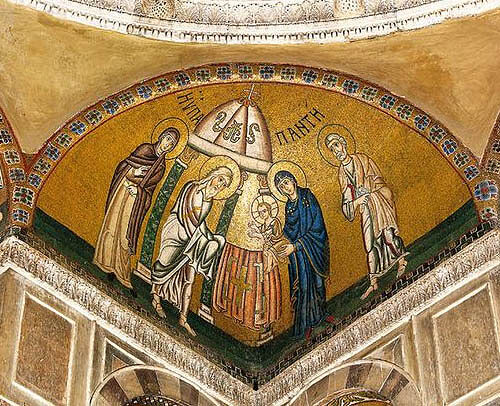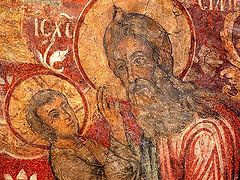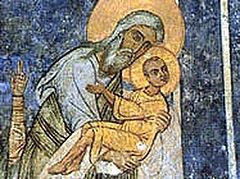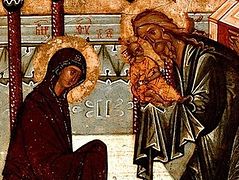And behold, there was a man in Jerusalem whose name was Simeon, and this man was just and devout, waiting for the Consolation of Israel, and the Holy Spirit was upon him. And it had been revealed to him by the Holy Spirit that he would not see death before he had seen the Lord’s Christ. So he came by the Spirit into the temple. And when the parents brought in the Child Jesus, to do for Him according to the custom of the law, he took Him up in his arms and blessed God and said: “Lord, now You are letting Your servant depart in peace, according to Your word; for my eyes have seen Your salvation which You have prepared before the face of all peoples, a light to bring revelation to the Gentiles, and the glory of Your people Israel.” (Luke 2:25-32)
While the American news media will regale us on February 2 with nonsense about a groundhog forecasting the weather, in the Church on this day we remember the event of Mary and Joseph taking the 40-day old baby Jesus to the Temple in fulfilment of the Law to make an offering to God for their newborn son. The Church remembers the event in the Feast of the Meeting of the Lord in the Temple. The Gospel event is interpreted as having great theological meaning as it explores the relationship between the Messiah, the Torah and the Temple. In the narrative, the holy Simeon proclaims upon gazing on Jesus that he now sees with his own eyes God’s salvation. He sees not just the Savior but salvation itself (or salvation personified). Salvation is not an event, but a person—Jesus the incarnate God. When we look upon an icon of Jesus, we are seeing our salvation!
For this Feast of the Meeting of the Lord in the Temple, I offer three thoughts about the temple. First, Roman Catholic scholar Jean Danielou points out that as far back as Methodius of Olympus (d. 311AD), the Temple had a spiritual significance which went way beyond it just being the place where God dwelt on earth. The Temple is important because it helps reveal to us the different levels of reality in which we function and in which God reveals Himself. The Temple connects the heavenly reality with the Old Testament (the Tabernacle) and with the New Testament (the Church). Christ’s appearance in the Temple is bringing together all the promises and prophecies of the Old Testament, not only with their fulfillment in the New Testament, but with the eschatological Kingdom of Heaven, thus uniting all things in history and heaven together in Christ (time and eternity are united in Christ).
“Methodius would seem, therefore, to assume three levels of reality: the Jewish Tabernacle was the shadow (skia), the church is the image (eikon), and the heavenly city is the reality (aletheia).” (GOSPEL MESSAGE AND HELLENISTIC CULTURE, p 291)

What the Old Testament Jews could only perceive in a foreshadowing, the Church reveals and yet it remains still an icon of the reality which is the Kingdom itself: there is much more to come, maybe even the best is yet to come.
Second, Robert Taft, another Roman Catholic scholar, reminds us that our parish buildings are not in fact temples. Rather, in the early Church it was the people themselves assembled together who were the Temple of God, for God dwelt in His people, not in a building.
“A Christian church is not a temple. Originally the community, and not some material shrine, was the dwelling of God’s presence. In time it became customary to see the church building as a symbol of the mysteries it housed.” (THE BYZANTINE RITE: A SHORT HISTORY, p 36)
Remembering that it is the parish community gathered together that forms God’s Temple, not the parish building (no matter how gilded it is nor if it is a perfect Byzantine design). Thus we, the parishioners form the Temple of God, and even if we have to be absent from the communal liturgy, we still are God’s Temple wherever we go. Even if we never went to a church building, as the Body of Christ we would still form God’s temple on earth.
Third, when we realize we the community of believers (whether assembled or scattered) form God’s temple, we come to understand we can never leave God’s temple, because we are that temple and thus if we remain faithful, we bring God wherever we happen to be.
“Do not indulge despondency and distress if illness prevents you from going to church. The apostle has told us that we ourselves are the temple of the living God (2 Cor 6:16). Let that temple suffice you.” (Macarius of Optina, RUSSIAN LETTERS OF SPIRITUAL DIRECTION 1834-1860, p 62)
For we are the temple of the living God; as God said, “I will live in them and move among them, and I will be their God, and they shall be my people. (2 Corinthians 6:16)
So then you are no longer strangers and sojourners, but you are fellow citizens with the saints and members of the household of God, built upon the foundation of the apostles and prophets, Christ Jesus himself being the cornerstone, in whom the whole structure is joined together and grows into a holy temple in the Lord; in whom you also are built into it for a dwelling place of God in the Spirit. (Ephesians 2:19-22)
And I saw no temple in the city, for its temple is the Lord God the Almighty and the Lamb. (Revelation 21:22)
There will be no church building in God’s Kingdom for God Himself will be our Temple! And we will abide in Him and He in us. The Feast of the Meeting of the Lord in the Temple claims the role of the Temple on earth has been fulfilled and so the Temple is passing away. For now we, God’s people, the Church, are God’s Temple on earth. In heaven, He will be our Temple.




